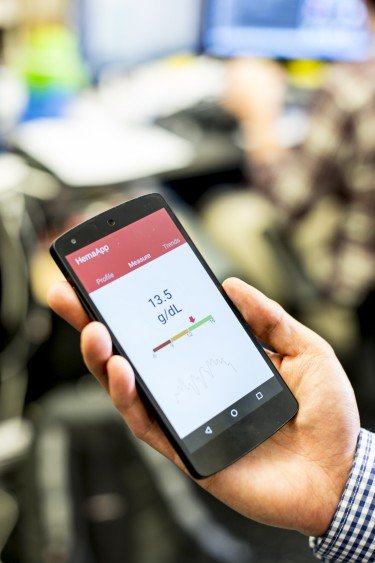
HemaApp measures hemoglobin levels and screens for anemia non-invasively by illuminating the patient’s finger with a smartphone’s camera flash.Dennis Wise/University of Washington
In both cases, doctors are interested in measuring hemoglobin, a protein found in red blood cells. To obtain this basic measurement, health care providers either have to draw blood with a needle or intravenous line, or spend hundreds to thousands of dollars on a specialized machine that measures hemoglobin
Now, electrical engineers and computer scientists from the University of Washington have developed HemaApp, which uses a smartphone camera to estimate hemoglobin concentrations and screen for anemia. The new technology is described in a paper that received a «Best Paper» award and will be presented Sept. 15 at the Association for Computing Machinery’s 2016 International Joint Conference on Pervasive and Ubiquitous Computing (UbiComp 2016) in Germany.
In an initial trial of 31 patients, and with only one smartphone modification, HemaApp performed as well as the Masimo Pronto, the more expensive Food and Drug
«In developing countries, community health workers have so much specialized equipment to monitor different conditions that they literally have whole bags full of devices," said lead author and UW electrical engineering doctoral student Edward Wang. «We are trying to make these screening tools work on one ubiquitous platform — a smartphone.»
By shining light from the phone’s camera flash through the patient’s finger, HemaApp analyzes the color of his or her blood to estimate hemoglobin concentrations. The researchers tested the app under three different scenarios: using the smartphone camera’s flash alone, in combination with a common incandescent lightbulb, and with a

HemaApp uses illumination sources from a smartphone, in combination with other light sources, and algorithms that analyze the color of a patient’s blood to estimate hemoglobin levels. University of Washington
The additional illumination sources tap into other parts of the electromagnetic spectrum that have useful absorption properties but that aren’t currently found on all smartphone cameras.
«New phones are beginning to have more advanced infrared and
In the initial trials, HemaApp’s hemoglobin measurements using a smartphone camera alone had a 69 percent correlation to a patient’s Complete Blood Count (CBC) test, a 74 percent correlation when used under a common incandescent light bulb and an 82 percent correlation using a small circle of LED lights that can snap onto the phone.
For comparison, the Masimo Pronto’s measurements had an 81 percent correlation to the blood test.

In an initial trial of 31 patients, HemaApp’s results compared favorably to an FDA-approved medical device that also measures hemoglobin without using blood draws.Dennis Wise/University of Washington
«Anemia is one of the most common problems affecting adults and children worldwide," said
«Every time we draw blood, we are invading the patient in some way, shape or form. If we don’t already have a line in, we are sticking a needle into their arm, which involves discomfort and infection risk, albeit low," she said. «It would be really nice to not have to perform a procedure every time we want to answer that question.»
HemaApp draws on previous work from the UW’s UbiComp lab, which also developed Bilicam, a mobile app that uses a smartphone’s camera and flash to infer the amount of bilirubin in the blood for newborn jaundice. Bilicam just completed a nationwide clinical trial of 500 newborns.
HemaApp bombards a patient’s finger with different wavelengths of light and infrared energy and creates a series of videos. By analyzing how colors are absorbed and reflected across those wavelengths, it can detect concentrations of hemoglobin and other blood components like plasma.
To ensure that it works on different skin tones and body masses, the team developed processing algorithms that use the patient’s pulse to distinguish between the properties of the patient’s blood and the physical characteristics of his or her finger.
Next research steps include wider national and international testing of HemaApp, collecting more data to improve accuracy rates, and using smartphones to try to detect abnormal hemoglobin properties that could help screen for sickle cell disease and other blood disorders.
«We’re just starting to scratch the surface here," said Patel. «There’s a lot that we want to tackle in using phones for
The research was funded by the endowment of the Washington Research Foundation.


